At WPBeginner, we use SEO reports as health checklists for our websites. They tell us at a glance how well our sites are doing and what we need to do to rank higher.
When you create an SEO report, you generate an actionable list of tasks you need to do to improve your website’s SEO. This allows you to optimize your site for SEO by checking off items on a list, which can result in more traffic coming to your site.
In this article, we’ll show you step-by-step how to create an SEO report. This will give you a clear path to optimizing your site for search engines, one issue at a time.

Why Do You Need an SEO Report for Your WordPress Site?
Improving your WordPress SEO is important because it helps you get more website traffic.
Search engines are the biggest source of visitors for most websites. SEO, or Search Engine Optimization, is a process that improves your website rankings so your site appears closer to the top of search engine results pages (SERPs).
The problem is that SEO is a complex process, and it can be difficult for beginners to know where to start. This is where an SEO report can help.
Performing an SEO analysis will give you a score on your site’s current SEO effectiveness. It will also generate a report of actionable tasks you can perform to increase organic traffic to your website.
You can think of an SEO report as a to-do list you can follow to optimize SEO, improve website traffic, and boost your sales and conversions.
Expert Tip: Would you like an SEO expert to optimize your site for you? Our Professional SEO Services start at just $649 and include setting up AIOSEO and Google Analytics, keyword research, on-page optimization, a domain overview report, and much more.
With that being said, let’s take a look at how to create an SEO report for your WordPress site. We will cover two methods:
1. Creating an SEO Report Using All in One SEO (Free)
You might like to create an SEO report that you can easily view from your WordPress dashboard. The easiest way to do that is with All in One SEO (AIOSEO), the best SEO plugin for WordPress that is trusted by over 3 million businesses.
AIOSEO automatically creates an SEO report for your WordPress website that helps you optimize it for search engines without hiring an expert. The plugin offers an SEO Analysis tool that you can use to identify the SEO tasks you have not yet completed.
We have written a complete AIOSEO review where you can learn more about the plugin.
Note: For this tutorial, we will use the AIOSEO free version because it includes the SEO Analysis tool. There is also a premium version of AIOSEO that offers more features, including sitemap tools, schema markup, a redirection manager, and more.
Installing and Activating All in One SEO
To get started, you need to install and activate the AIOSEO plugin on your website. For more details, you can follow our guide on how to install a WordPress plugin.
Once it is activated, the plugin will automatically launch a setup wizard. You need to click the ‘Let’s Get Started’ button to continue.

You can see detailed instructions for configuring the plugin in our tutorial on how to set up All in One SEO for WordPress.
When you are ready, simply head over to the All in One SEO » SEO Analysis page in your WordPress dashboard. You will find yourself looking at the ‘SEO Audit Checklist’ tab.
TruSEO Score
The first thing you will notice is that All in One SEO has given your website a score for its overall SEO. This is the plugin’s TruSEO score, where a good score is between 50 and 75, and the best SEO results come with a score above 70.
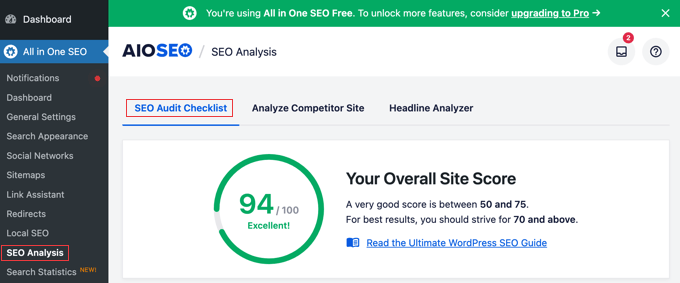
You improve the score by optimizing your website for SEO. This is where an SEO report is helpful.
You will notice that All in One SEO creates an actionable, easy-to-understand SEO checklist. It shows you the exact steps you need to take to improve your TruSEO score.
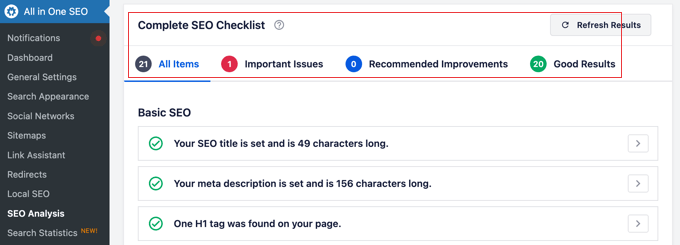
These steps are displayed in four sections: ‘Basic SEO,’ ‘Advanced SEO,’ ‘Performance,’ and ‘Security.’
If you have already made some SEO improvements with good results, you will see them next to a green check mark. Important issues that need work will have a red cross. Recommended improvements are marked in blue.
You can filter the list to see just the red, blue, or green items by clicking the tabs above the list.
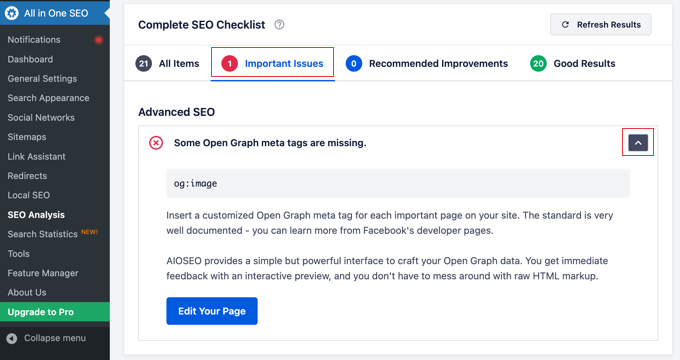
You can easily click the arrow to the right of each checklist item to read more details about it. This will help you understand why that item is important for SEO and how you can fix the issue.
Basic SEO Report
The first section of your SEO report is ‘Basic SEO’, which focuses on the basic elements of on-page SEO. This is the best place to start.
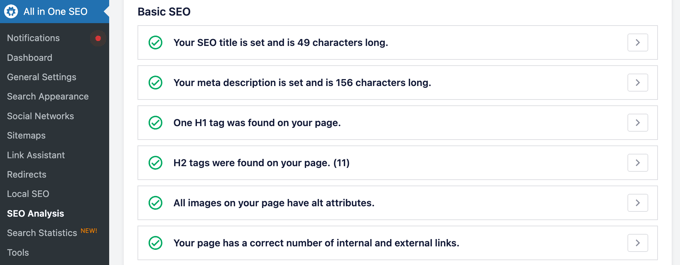
Here are some optimization tasks included in the ‘Basic SEO’ checklist:
- Make sure your site’s SEO title and meta description are not too long or too short for the best SEO results.
- Include appropriate keywords in your H1 and H2 heading tags.
- Check that you are adding alt tags to your images.
- See if you are using the correct number of internal and external links.
Advanced SEO Report
Next, you will find the ‘Advanced SEO’ checklist, which looks deeper into the best practices of technical SEO.
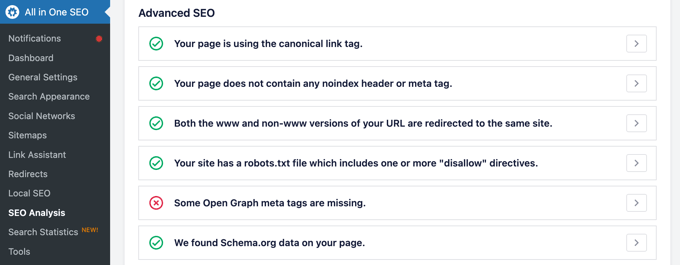
This checklist includes more advanced SEO issues:
- You can check that your site uses a canonical link tag that lets search engines know the correct URL of your website.
- It makes sure that you are not accidentally using noindex headers or meta tags that ask search engines not to index your pages.
- It checks the www and non-www versions of your website’s URL redirect to the same site.
- The checklist will warn you if you are not using a robots.txt file to help search engines crawl and index your site more easily.
- You can also see whether you are using schema markup to display additional information about your site in search results.
Performance Report
The third section of the SEO report is ‘Performance,’ which measures the speed and performance of your WordPress website. Slow websites are bad for both SEO and user experience.
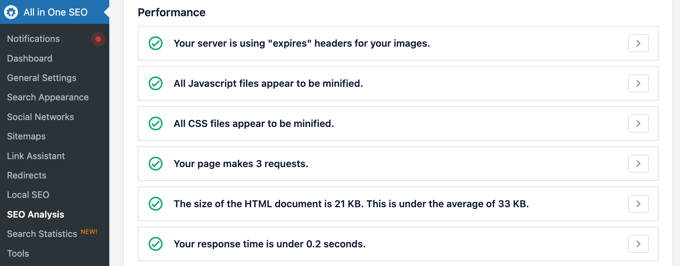
The ‘Performance’ checklist includes the following items that can improve your site’s SEO:
- You should make sure you are using expires headers for your images.
- Also make sure you are minifying JavaScript and CSS in WordPress.
- This checklist lets you know if your HTML pages are larger or smaller than average.
- It measures your website response time, which can be improved by using a caching plugin.
Security Report
The final section in AIOSEO’s SEO report is ‘Security.’ Website security is essential for protecting user data and maintaining search engine trust.

Here are the ‘Security’ items in All in One SEO’s checklist that can help boost your SEO:
- It makes sure that directory listing is disabled on your site because this makes it more difficult for hackers to access your website files.
- It checks that Google has not blacklisted your website for malware because Google will de-index suspicious websites.
- It also makes sure your site is using the secure HTTPS protocol to protect the privacy of your users. We recommend that all websites enable HTTPS. Otherwise, Google will mark the site as insecure, giving a bad impression of your business.
Now that you have a detailed SEO report covering four important areas, you can start to work on one issue or improvement at a time. As you make progress, you will notice your red items turning green and your TruSEO score increasing. This will lead to more organic traffic from search engines.
2. Creating an SEO Report Using Website SEO Analyzer (Free)
This method does not require any setup, but you will not be able to see the report in your WordPress dashboard. You will also have to create the report each time you want to see it.
Simply visit the WPBeginner Website SEO Analyzer page. Once there, you need to type in your website’s URL and then click the ‘Analyze’ button.
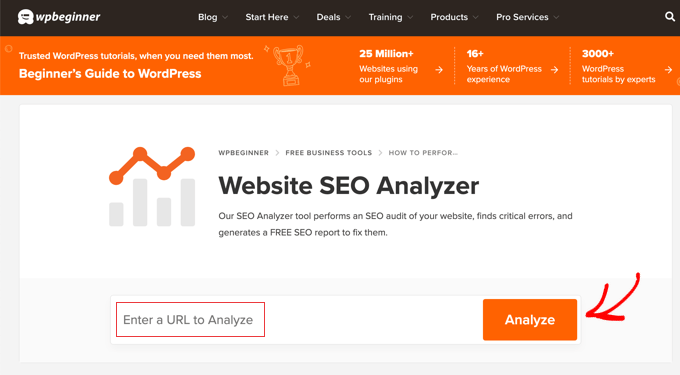
Tip: You can also type in the URL to a competitor’s website to perform a competitor analysis.
After you click on the ‘Analyze’ button, an SEO report will be generated. This includes an overall SEO score as well as sections for basic SEO, advanced SEO, performance, and security.
You’ll also find a button that lets you download the SEO report to your computer as a PDF.
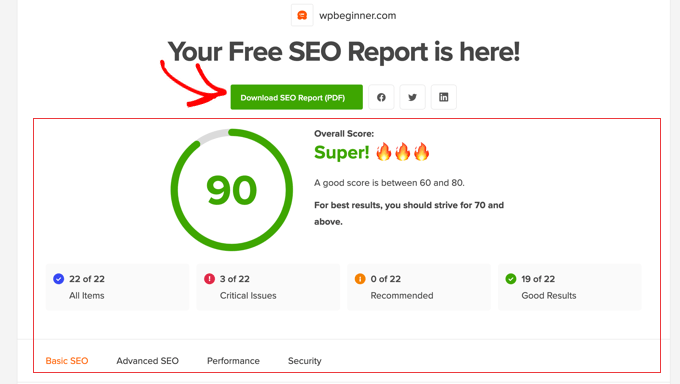
As you can see, the free SEO report gives you most of the information from the ‘SEO Analysis’ tab in All in One SEO. Please refer to the above section for more details.
Expert Guides Related to SEO
We hope this tutorial helped you learn how to create an SEO report for your WordPress site. You may also want to see some other guides related to WordPress search engine optimization:
- Ultimate WordPress SEO Guide for Beginners (Step by Step)
- WordPress SEO Audit Checklist to Boost Your Rankings
- How to Add the Ultimate SEO Dashboard in WordPress
- How to Double Your SEO Traffic in 6 Months (With Case Studies)
- How Long Does Website SEO Take to Show Results? (Real Data)
- How to Add Schema Markup in WordPress and WooCommerce
- Why Did My WordPress Site Get De-Indexed From Google?
- Best Online Content Optimization Tools for WordPress
If you liked this article, then please subscribe to our YouTube Channel for WordPress video tutorials. You can also find us on Twitter and Facebook.
The post How to Create an SEO Report for Your WordPress Site first appeared on WPBeginner.
